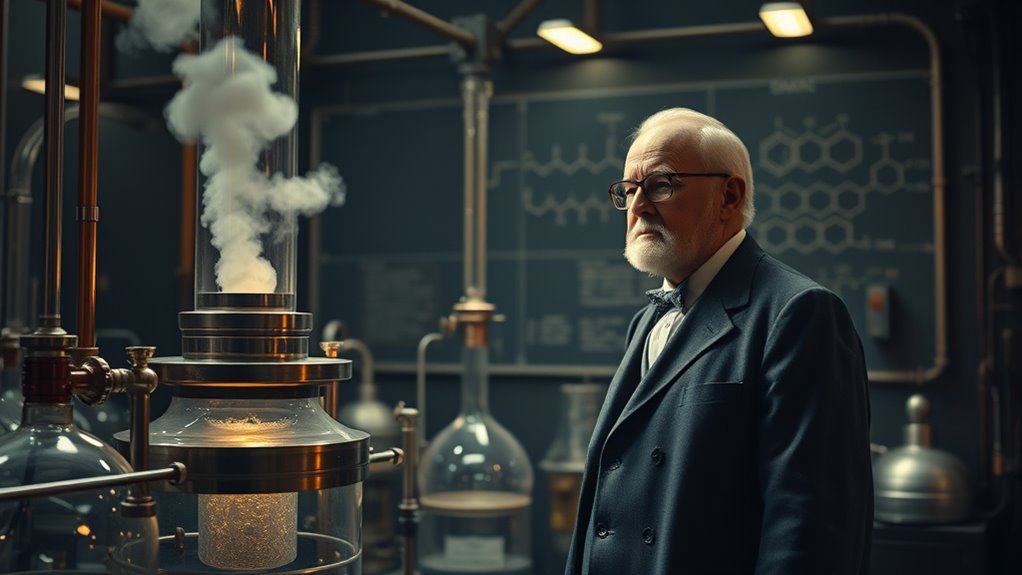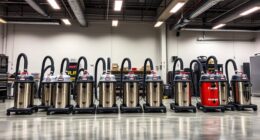Fritz Haber revolutionized chemistry by developing the Haber-Bosch process, which allows you to turn atmospheric nitrogen into ammonia on an industrial scale. This breakthrough transformed agriculture by producing fertilizers that dramatically increased crop yields worldwide. While it boosted food supply, it also had military uses during World War I. His work shows how one discovery can reshape society in both positive and complex ways—continue exploring to see how Haber’s invention still influences us today.
Key Takeaways
- Fritz Haber developed the Haber-Bosch process, enabling large-scale synthesis of ammonia from atmospheric nitrogen.
- This breakthrough revolutionized fertilizer production, boosting global food security and supporting the Green Revolution.
- Haber’s work bridged scientific innovation with industrial application, earning him the Nobel Prize in Chemistry in 1918.
- His process transformed agriculture by replacing natural nitrogen sources, increasing crop yields worldwide.
- The invention also had military uses during World War I, highlighting ethical debates over scientific dual-use applications.

Have you ever wondered how a single chemical process revolutionized agriculture and warfare? It all started with Fritz Haber, a brilliant chemist whose groundbreaking work in chemical synthesis transformed the way we produce fertilizers and explosives. Before Haber’s discovery, farmers relied heavily on natural sources like manure and guano, which limited crop yields and constrained global food supplies. Haber’s ability to engineer a method for synthesizing ammonia from atmospheric nitrogen changed that paradigm entirely. This process, known as the Haber-Bosch process, allows us to convert nitrogen gas into ammonia efficiently at an industrial scale, providing a steady and abundant supply of fertilizer that has fueled the Green Revolution. Without it, feeding the world’s growing population would be much more challenging.
Fritz Haber’s breakthrough in synthesizing ammonia revolutionized agriculture and warfare worldwide.
Haber’s work didn’t just impact agriculture; it also had profound military implications. During World War I, the same chemical synthesis that created fertilizer was adapted to produce explosives, giving nations a powerful advantage. The ability to manufacture ammonia on a large scale meant that armies could produce vast quantities of explosive materials, prolonging conflicts and shifting the nature of warfare. This dual-use of Haber’s discovery sparked intense debate about its ethical implications, but it also underscored the transformative power of chemical science.
Haber’s contributions didn’t go unnoticed in the scientific community. In 1918, he received Nobel recognition for his work in chemistry, specifically for the synthesis of ammonia. The Nobel Prize recognized the significance of his achievement, not just for its scientific ingenuity but for its practical impact on society. His work exemplifies how advances in chemical synthesis can have far-reaching consequences, influencing global food security and military capabilities alike. Despite the controversy surrounding his involvement in chemical warfare, Haber’s legacy remains rooted in his scientific brilliance and the revolutionary nature of his process.
As you look around today, it’s clear that Haber’s ammonia synthesis continues to shape the modern world. From feeding billions of people to powering industries and defense systems, his discovery exemplifies how a single scientific breakthrough can have an enduring influence. The Nobel recognition he received underscores the importance of innovation in chemistry, highlighting how scientific progress can lead to both remarkable benefits and complex ethical questions. In the end, Fritz Haber’s story reminds us that scientific pursuits often carry profound consequences—some beneficial, some challenging—yet all integral to the fabric of our modern civilization.
Frequently Asked Questions
How Did Fritz Haber’s Work Impact Global Food Security?
Your work with fertilizer technology and the development of industrial ammonia considerably boosted global food security. By enabling large-scale crop yield improvement, you helped farmers produce more food efficiently, reducing hunger worldwide. This breakthrough made essential fertilizers affordable and accessible, supporting population growth and stability. Your contributions laid the foundation for modern agriculture, ensuring that more people could be fed with less land and resources.
What Ethical Debates Surrounded Haber’s Contributions During Wartime?
Imagine standing at a crossroads where science meets morality. You’re faced with a conflict of military ethics and moral responsibility, knowing Haber’s work was pivotal in both fertilizing crops and fueling wartime explosives. This duality sparks debate: should scientific advancements be judged by their intentions or consequences? You grapple with the ethical dilemma, questioning whether Haber’s contributions serve humanity or deepen its suffering during wartime.
Were There Any Major Setbacks in Developing Industrial Ammonia?
You face major setbacks in developing industrial ammonia due to technical challenges like optimizing the high-pressure, high-temperature process required for synthesis. Environmental concerns also posed hurdles, as the production consumes significant energy and emits greenhouse gases. These issues slowed progress initially, forcing scientists and engineers to refine technology and address ecological impacts before achieving efficient, scalable ammonia manufacturing.
How Did Haber’s Personal Life Influence His Scientific Pursuits?
You might be surprised to learn that Haber’s personal motivations deeply fueled his scientific pursuits. His intense dedication stemmed from a desire to help Germany become self-sufficient, driven by patriotism and personal ambition. Yet, this same drive sometimes conflicted with scientific integrity, as he pushed forward despite ethical dilemmas. His personal life—marked by tragedy and unwavering resolve—created a complex backdrop that both inspired and haunted his groundbreaking work.
What Is the Current Status of the Haber-Bosch Process?
You should know that the Haber-Bosch process remains the primary method for producing synthetic ammonia today, essential for fertilizers. However, researchers are exploring sustainable alternatives due to environmental impacts, like high energy consumption and greenhouse gas emissions. Advances focus on greener catalysts and renewable energy sources, aiming to reduce the ecological footprint. These efforts could transform ammonia production into a more environmentally friendly process in the future.
Conclusion
As you reflect on Fritz Haber’s groundbreaking work, remember that he revealed the secret to transforming the air around you into life-sustaining fertilizer, much like Prometheus stole fire for mankind. His innovations revolutionized agriculture and industry, but also remind you that great power comes with responsibility. Just as Icarus soared too close to the sun, Haber’s legacy warns you to wield scientific progress wisely—balancing human advancement with ethical restraint.









